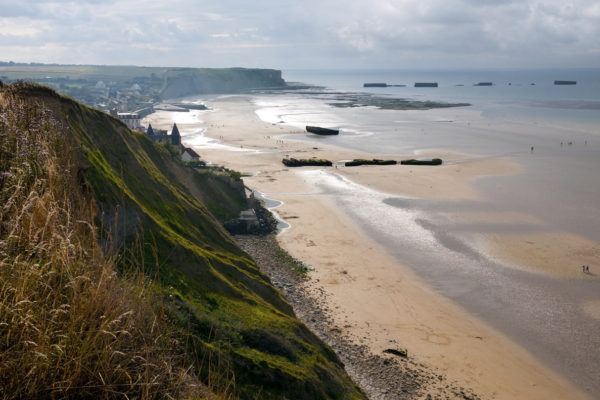On the eve of the 75th anniversary of the D-Day invasion, I find myself on Omaha Beach, leading a small band of college students into the past.
For more than 20 years, my colleagues and I have taken Normandy scholars students from The University of Texas at Austin to Europe as the culmination of a five-course, semester-long study of the Second World War. There’s nothing like being there to discover what happened there three-quarters of a century ago or how much it can teach us today.
On this day, we are hiking across Omaha Beach, where over 34,000 Americans splashed ashore on June 6, 1944 — D-Day. The other American landing beach, codenamed “Utah,” is due west. To the east lie one Canadian (“Juno”) and two British beaches (“Sword” and “Gold”).
Together, they occupy a 50-mile stretch of Norman coastline that was the target of the largest amphibious assault in history. “Operation Overlord,” the invasion of northern France, deposited more than 156,000 troops on the beaches of Normandy in a single day. The long-promised “Second Front” — the first being the Soviet-German front in the East, where some 27 million Russians died — had opened at last.
The scene we see today is incomparably beautiful. Puffy white clouds drift through an azure sky. Waves break gently, leaving a gauzy line of sea foam in their wake. Off-shore winds, no more than a few knots, barely stir the sand.
For many years, we ended our walk at the foot of the American cemetery and trudged up the steep bluff overlooking the beach, but not today. The path to the top is permanently closed for fear of a terrorist attack.
Instead, we board a bus and enter the cemetery like the million-plus tourists who visit it every year. A staff member greets us and tells us about the 9,380 gravesites marked by Latin crosses and Jewish stars carved from white Lasa marble. The German cemetery in nearby La Cambe, shrouded in dark granite, contains more than twice that number.
Surrounded by a semi-circular colonnade, we lay a wreath at the foot of the 22-foot bronze statue called “The Spirit of American Youth Rising from the Waves.”
We turn to face the cemetery as the national anthem plays on the loudspeaker. Visitors stop in their tracks, and hands cover hearts to honor the men and four women buried here. Tears well up in my eyes at the memory of my father, who flew 30 missions over France and Germany in the spring and summer of 1944.
Each student receives a yellow rose to place at the grave of a Texas soldier. The headstones give us only name, rank, unit, home state and date of death. We can guess how old they were, for the students are about the same age.
We return to the bluff, this time looking down at the peaceful scene below. We know the scene was anything but peaceful 75 years ago. “Bloody Omaha” was the deadliest beach of the invasion. More than 2,400 Americans were killed, wounded or went missing in action. No one who survived ever forgot it.
Our students understand the sacrifices made that day and the costs of war, both human and material. They face a world different from the one their grandfathers and great-grandfathers lived in but just as complex and even more dangerous.
Terrorism, nuclear proliferation and the threat of climate change present a combination of challenges, some of them existential, that no previous generation has faced. Many of the old scourges that produced D-Day — right-wing autocrats in Europe and Asia, great power rivalries across the globe, arms races, naked aggression, and perhaps the oldest scourge of all, anti-Semitism — enjoy new life.
I have faith that this generation of students will make the modern equivalent of D-Day unnecessary, especially if they discover what made the last one imperative. We can learn much from the history of D-Day and the Second World War about the importance of alliances, the value of cooperation and the meaning of courage. As it turns out, learning from the past is a matter of moment today.
Michael B. Stoff is an associate professor of history, a member of the Normandy Scholars Committee and a University Distinguished Teaching Professor at The University of Texas at Austin.
A version of this op-ed appeared in the Houston Chronicle, Corpus Christi Caller Times, Waco Tribune Herald, Austin American Statesman, Lubbock Avalanche Journal, Amarillo Globe News, Abilene Reporter News, and the San Antonio Express News.




